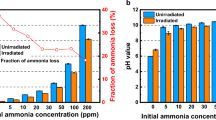Abstract
The effects of aluminum surface on I− oxidation under gamma irradiation were investigated. Without irradiation, only O2 oxidized I− at pH < 2, and aluminum expedited the oxidation reaction. With irradiation, the radiolysis products from water and air oxidized I− into \({{\text{I}}_{3}}^{ - } .\) At pH < 2, O2 generated by water radiolysis additionally oxidized I−. However, at pH > 6, the H2O2 radiolysis product reduced \({{\text{I}}_{3}}^{ - }\) into I−. A smaller amount of \({{\text{I}}_{3}}^{ - }\) was observed in pH 1.9 and 3.3 solutions in contact with aluminum under irradiation because oxidants preferentially oxidize aluminum rather than I−. Moreover, for pH < 6.0, even less \({{\text{I}}_{3}}^{ - }\) was formed by aluminum exposed to air because air radiolysis products also preferentially oxidized aluminum.










Similar content being viewed by others
References
Lin CC (1980) Chemical effects of gamma radiation on iodine in aqueous solutions. J Inorg Nucl Chem 42:1101–1107
Ishigure K, Shiraishi H, Okuda H, Fujita N (1986) Effect of radiation on chemical forms of iodine species in relation to nuclear reactor accidents. Radiat Phys Chem 28:601–610
Lucas M (1988) Radiolysis of cesium iodide solutions in conditions prevailing in a pressurized water reactor severe accident. Nucl Technol 82:157–161
Ashmore CB, Gwyther JR, Sims HE (1996) Some effects of pH on inorganic iodine volatility in containment. Nucl Eng Des 166:347–355
McFarlane J, Wren JC, Lemire RJ (2002) Chemical speciation of iodine source term to containment. Nucl Technol 138:162–178
Lin CC, Wang CF, Sun YC, Chao JH, Tseng CL (2005) Radiation effects on gaseous iodine at very low concentrations. J Radioanal Nucl Chem 268:419–424
Cantrel L (2006) Radiochemistry of iodine outcomes of the caiman program. Nucl Technol 156:11–28
Guentay S, Cripps R, Jaeckel B, Bruchertseifer H (2007) Radiochemical studies of the retention of volatile iodine in aqueous solutions. J Radioanal Nucl Chem 273:557–561
Bosland L, Funke F, Girault N, Langrock G (2008) Paris project: radiolytic oxidation of molecular iodine in containment during a nuclear reactor severe accident. Part 1. Formation and destruction of air radiolysis products—experimental results and modeling. Nucl Eng Des 238:3542–3550
Herranz LE, Clément B (2010) In-containment source term: key insights gained from a comparison between the PHEBUS-FP Programme and the US-NRC NUREG-1465 revised source term. Prog Nucl Energy 52:481–486
Bosland L, Funke F, Langrock G, Girault N (2011) Paris project: radiolytic oxidation of molecular iodine in containment during a nuclear reactor severe accident: Part 2. Formation and destruction of iodine oxides compounds under irradiation—experimental results modeling. Nucl Eng Des 241:4026–4044
Wren JC, Glowa GA, Merritt J (1999) Corrosion of stainless steel by gaseous I2. J Nucl Mater 265:161–177
Glanneskog H, Jan-Olov L, Sihver L (2006) Reactions between reactive metals and iodine in aqueous solutions. J Nucl Mater 348:87–93
Glanneskog H (2004) Interactions of I2 and CH3I with reactive metals under BWR severe-accident conditions. Nucl Eng Des 227:323–329
Tietze S, Foreman M, Ekberg C, Kärkelä T, Auvinen A, Tapper, U, Jokiniemi J (2013) Adsorption and revaporisation studies of thin iodine oxide and CsI aerosol deposits from containment surface materials in LWRs. NKS-R, NKS-285. ISBN 978-87-7893-360-7
Wren JC, Paquette J, Sunder S, Ford BL (1986) Iodine chemistry in the +1 oxidation state. II. A Raman and UV–visible spectroscopic study of the disproportionation of hypoiodite in basic solutions. Can J Chem 64:2284–2296
Rahn RO (1991) Determination of iodide formed from inorganic iodine in aqueous solution. Anal Chim Acta 248:595–602
Jung SH, Yeon JW, Kang Y, Song K (2014) Determination of triiodide ion concentration using UV–visible spectrophotometry. Asian J Chem 26:4084–4086
Jung SH, Yeon JW, Hong SY, Kang Y, Song K (2015) The oxidation behavior of iodide ion under gamma irradiation conditions. Nucl Sci Eng 181:191–203
Wren JC, Ball JM, Glowa GA (2000) The chemistry of iodine in containment. Nucl Technol 129:297–325
Karasawa H, Endo M (1996) Effect of nitrogen and oxygen on radiolysis of iodide solution. International Atomic Energy Agency, Geneva
Bard AJ, Faulkner LR (1980) Electrochemical methods: fundamentals and applications. Wiley, Toronto
Evans GJ, Mirbod SM, Jervis RE (1993) The volatilization of iodine species over dilute iodide solutions. Can J Chem Eng 71:761–765
Carpenter JH (1965) The Chesapeake Bay Institute technique for the Winkler dissolved oxygen method. Limnol Oceanogr 10:141–143
Acknowledgments
This work was supported by the Nuclear Research and Development Program through the National Research Foundation of Korea and funded by the Ministry of Science, Information Communication Technology and Future Planning, Republic of Korea.
Author information
Authors and Affiliations
Corresponding author
Rights and permissions
About this article
Cite this article
Hong, S.Y., Jung, SH. & Yeon, JW. Effect of aluminum metal surface on oxidation of iodide under gamma irradiation conditions. J Radioanal Nucl Chem 308, 459–468 (2016). https://doi.org/10.1007/s10967-015-4503-9
Received:
Published:
Issue Date:
DOI: https://doi.org/10.1007/s10967-015-4503-9




